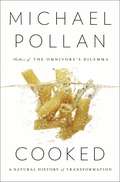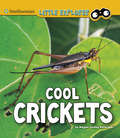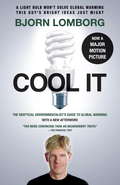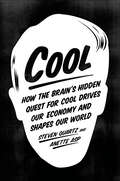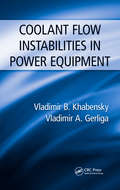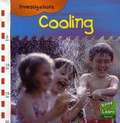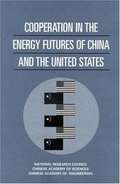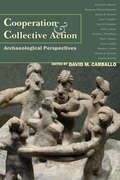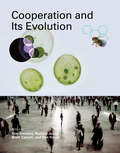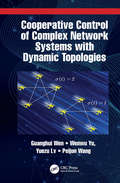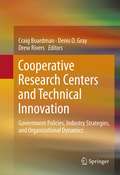- Table View
- List View
Cooked: A Natural History of Transformation
by Michael PollanIn Cooked, Michael Pollan explores the previously uncharted territory of his own kitchen, discovering the enduring power of the four classical elements -- fire, water, air, and earth -- to transform the stuff of nature into delicious things to eat and drink.
Cool Crickets (Little Entomologist 4D)
by Megan Cooley PetersonChirping fills the night air, and you know crickets must be nearby! But did you also know that each species has its own unique song? Or that these tiny jumpers have ears on their legs? Meet cool crickets from around the world with Smithsonian Little Entomologist. Kids will be wowed by the amazing variety of bugs and up-close photos, while also learning about bug behavior, life cycle, diet, and more. The engaging, leveled text supports life science curriculum.
Cool It: The Skeptical Environmentalist's Guide to Global Warming
by Bjørn LomborgGlobal warming has become one of the permanent concerns of our time, with ever stronger calls to combat it via drastic programs, like the Kyoto Protocol. In this highly controversial book, Bjorn Lomborg (author of the bestselling The Skeptical Environmentalist) claims that the arguments for such action are little more than scare mongering and exposes this wide range of disinformation. Global warming is happening. It's a serious and important problem and we need to deal with it in a responsible way. B...
Cool: How the Brain's Hidden Quest for Cool Drives Our Economy and Shapes Our World
by Steven Quartz Anette Asp“This engrossing history merges evolutionary biology and economics to explain our spending habits” and show how coolness is at the heart of consumerism (Mental Floss).We live in a world of conspicuous consumption, where the things we buy not only satisfy our needs, but also communicate our values, identities, and aspirations. In Cool, Steven Quartz and Anette Asp bring together groundbreaking findings in neuroscience, economics, and evolutionary biology to show how our concepts of “cool”—be it designer jeans, smartphones, or craft beer—help drive the global economy.Cool puts forth a provocative theory of consumerism based on our brain’s innate status-seeking and “social calculator”. The authors highlight the underlying processes that guide our often-unconscious decision making. They also pull back the curtain on “choice architects” who design store interiors, as well as “coolhunters” who scour Berlin and Tokyo for the latest trends.Quartz and Asp follow the evolution of “cool consumption” from the mid-twentieth century through the emergence of the Internet in the 1990s, finally unpacking the social motivations behind today’s hip, ethical consumption. Taking us from Norman Mailer to normcore, Cool is surprising at every turn, and will forever change the way you think about money, status, and your next purchase.
Coolant Flow Instabilities in Power Equipment
by Vladimir B. Khabensky Vladimir Antonovich GerligaThermal-hydraulic instability can potentially impair thermal reliability of reactor cores or other power equipment components. Thus it is important to address stability issues in power equipment associated with thermal and nuclear installations, particularly in thermal nuclear power plants, chemical and petroleum industries, space technology, and r
Cooling
by Patricia WhitehousePart of the Read and Learn collection, the books in the Investigations series explore the forces and motions involved in familiar activities and include experiments for children to try out.
Cooling Electrons in Nanoelectronic Devices by On-Chip Demagnetisation (Springer Theses)
by Alexander Thomas JonesThis thesis demonstrates that an ultralow temperature refrigeration technique called "demagnetisation refrigeration" can be miniaturised and incorporated onto millimeter-sized chips to cool nanoelectronic circuits, devices and materials. Until recently, the lowest temperature ever reached in such systems was around 4 millikelvin. Here, a temperature of 1.2mK is reported in a nanoelectronic device. The thesis introduces the idea that on-chip demagnetization refrigeration can be used to cool a wide variety of nanostructures and devices to microkelvin temperatures. This brings the exciting possibility of discovering new physics, such as exotic electronic phases, in an unexplored regime and the potential to improve the performance of existing applications, including solid-state quantum technologies. Since the first demonstration of on-chip demagnetization refrigeration, described here, the technique has been taken up by other research groups around the world. The lowest on-chip temperature is currently 0.4mK. Work is now underway to adapt the technique to cool other materials and devices, ultimately leading to a platform to study nanoscale materials, devices and circuits at microkelvin temperatures.
Cooperation In The Energy Futures Of China And The United States
by National Research Council Staff Chinese Academy of Science Staff Chinese Academy of Engineering StaffToday we recognize the importance of the pending transition in energy resource utilization in the coming century. Two major players in this transition will be two of the world's superpowers - - China and the United States. Cooperation in the Energy Futures of China and the United States focuses on collaborative opportunities to provide affordable, clean energy for economic growth and social development, to minimize future energy concerns, environmental threats to our global society, and the health and economic impacts on energy production and use.
Cooperation and Collective Action: Archaeological Perspectives
by David M. CarballoPast archaeological literature on cooperation theory has emphasized competition's role in cultural evolution. As a result, bottom-up possibilities for group cooperation have been under theorized in favor of models stressing top-down leadership, while evidence from a range of disciplines has demonstrated humans to effectively sustain cooperative undertakings through a number of social norms and institutions. Cooperation and Collective Action is the first volume to focus on the use of archaeological evidence to understand cooperation and collective action. Disentangling the motivations and institutions that foster group cooperation among competitive individuals remains one of the few great conundrums within evolutionary theory. The breadth and material focus of archaeology provide a much needed complement to existing research on cooperation and collective action, which thus far has relied largely on game-theoretic modeling, surveys of college students from affluent countries, brief ethnographic experiments, and limited historic cases. In Cooperation and Collective Action, diverse case studies address the evolution of the emergence of norms, institutions, and symbols of complex societies through the last 10,000 years. This book is an important contribution to the literature on cooperation in human societies that will appeal to archaeologists and other scholars interested in cooperation research.
Cooperation and Conflict: The Interaction of Opposites in Shaping Social Behavior
by Walter Wilczynski Sarah F. BrosnanUnderstanding the interaction between cooperation and conflict in establishing effective social behaviour is a fundamental challenge facing societies. Reflecting the breadth of current research in this area, this volume brings together experts from biology to political science to examine the cooperation–conflict interface at multiple levels, from genes to human societies. Exploring both the exciting new directions and the biggest challenges in their fields, the authors focus on identifying commonalities across species and disciplines to help understand what features are shared broadly and what are limited to specific contexts. Each chapter is written to be accessible to students and researchers from interdisciplinary backgrounds, with text boxes explaining terminology and concepts that may not be familiar across disciplinary boundaries, while being a valuable resource to experts in their fields.
Cooperation and Its Evolution
by Kim Sterelny Richard Joyce Brett Calcott Ben FraserThis collection reports on the latest research on an increasingly pivotal issue for evolutionary biology: cooperation. The chapters are written from a variety of disciplinary perspectives and utilize research tools that range from empirical survey to conceptual modeling, reflecting the rich diversity of work in the field. They explore a wide taxonomic range, concentrating on bacteria, social insects, and, especially, humans. Part I ("Agents and Environments") investigates the connections of social cooperation in social organizations to the conditions that make cooperation profitable and stable, focusing on the interactions of agent, population, and environment. Part II ("Agents and Mechanisms") focuses on how proximate mechanisms emerge and operate in the evolutionary process and how they shape evolutionary trajectories. Throughout the book, certain themes emerge that demonstrate the ubiquity of questions regarding cooperation in evolutionary biology: the generation and division of the profits of cooperation; transitions in individuality; levels of selection, from gene to organism; and the "human cooperation explosion" that makes our own social behavior particularly puzzling from an evolutionary perspective.
Cooperation and Its Evolution (Life and Mind: Philosophical Issues in Biology and Psychology)
by Kim Sterelny Richard Joyce Brett Calcott Ben FraserEssays from a range of disciplinary perspectives show the central role that cooperation plays in structuring our world.This collection reports on the latest research on an increasingly pivotal issue for evolutionary biology: cooperation. The chapters are written from a variety of disciplinary perspectives and utilize research tools that range from empirical survey to conceptual modeling, reflecting the rich diversity of work in the field. They explore a wide taxonomic range, concentrating on bacteria, social insects, and, especially, humans.Part I ("Agents and Environments") investigates the connections of social cooperation in social organizations to the conditions that make cooperation profitable and stable, focusing on the interactions of agent, population, and environment. Part II ("Agents and Mechanisms") focuses on how proximate mechanisms emerge and operate in the evolutionary process and how they shape evolutionary trajectories. Throughout the book, certain themes emerge that demonstrate the ubiquity of questions regarding cooperation in evolutionary biology: the generation and division of the profits of cooperation; transitions in individuality; levels of selection, from gene to organism; and the "human cooperation explosion" that makes our own social behavior particularly puzzling from an evolutionary perspective.
Cooperative Breeding in Vertebrates
by Koenig, Walter D. den Ridder, Stef Walter D. Koenig Stef Den RidderCooperative breeders are species in which individuals beyond a pair assist in the production of young in a single brood or litter. Although relatively rare, cooperative breeding is widespread taxonomically and continues to pose challenges to our understanding of the evolution of cooperation and altruistic behavior. Bringing together long-term studies of cooperatively breeding birds, mammals, and fishes, this volume provides a synthesis of current studies in the field. The chapters are organised by individual studies of particular species or (in the case of mole-rats) two closely related cooperatively breeding species. Each focuses not only on describing behavior and ecology but also on testing evolutionary hypotheses for the form and function of the diverse and extraordinary cooperative breeding lifestyles that have been discovered. This unique and comprehensive text will be of interest to graduate students and researchers of behavioral ecology and the evolution of cooperation.
Cooperative Control of Complex Network Systems with Dynamic Topologies
by Wenwu Yu Guanghui Wen Yuezu Lv Peijun WangFar from being separate entities, many social and engineering systems can be considered as complex network systems (CNSs) associated with closely linked interactions with neighbouring entities such as the Internet and power grids. Roughly speaking, a CNS refers to a networking system consisting of lots of interactional individuals, exhibiting fascinating collective behaviour that cannot always be anticipated from the inherent properties of the individuals themselves. As one of the most fundamental examples of cooperative behaviour, consensus within CNSs (or the synchronization of complex networks) has gained considerable attention from various fields of research, including systems science, control theory and electrical engineering. This book mainly studies consensus of CNSs with dynamics topologies - unlike most existing books that have focused on consensus control and analysis for CNSs under a fixed topology. As most practical networks have limited communication ability, switching graphs can be used to characterize real-world communication topologies, leading to a wider range of practical applications. This book provides some novel multiple Lyapunov functions (MLFs), good candidates for analysing the consensus of CNSs with directed switching topologies, while each chapter provides detailed theoretical analyses according to the stability theory of switched systems. Moreover, numerical simulations are provided to validate the theoretical results. Both professional researchers and laypeople will benefit from this book.
Cooperative Control of Multi-agent Systems: A Hybrid System Approach
by Changchun Hua Shuang Liu Guanglei Zhao Hailong CuiThis book focuses on stability analysis and control design approaches for multi-agent systems under network-induced constraints. A hybrid system approach is introduced to address the cooperative control problem of networked multi-agent systems, and several important topics such as asynchronous sampled data cooperative control, hybrid event-triggered cooperative control, and reset-based cooperative control are studied under the hybrid system framework. The special feature of this book is that a hybrid systems approach is proposed for the cooperative control of multi-agent systems, which is beneficial for relaxing the conservativeness of stability analysis and network parameter computation. Interested readers can learn a novel approach to cooperative control of multi-agent systems, and this book can benefit researchers, engineers, and graduate students in the fields of multi-robot cooperation, unmanned aerial vehicle formation, control engineering, etc.
Cooperative Control of Nonlinear Networked Systems: Infinite-time and Finite-time Design Methods (Communications and Control Engineering)
by Yongduan Song Yujuan WangCooperative Control of Nonlinear Networked Systems is concerned with the distributed cooperative control of multiple networked nonlinear systems in the presence of unknown non-parametric uncertainties and non-vanishing disturbances under certain communication conditions. It covers stability analysis tools and distributed control methods for analyzing and synthesizing nonlinear networked systems. The book presents various solutions to cooperative control problems of multiple networked nonlinear systems on graphs. The book includes various examples with segments of MATLAB® codes for readers to verify, validate, and replicate the results. The authors present a series of new control results for nonlinear networked systems subject to both non-parametric and non-vanishing uncertainties, including the cooperative uniformly ultimately bounded (CUUB) result, finite-time stability result, and finite-time cooperative uniformly ultimately bounded (FT-CUUB) result. With some mathematical tools, such as algebraic graph theory and certain aspects of matrix analysis theory introduced by the authors, the readers can obtain a deeper understanding of the roles of matrix operators as mathematical machinery for cooperative control design for multi-agent systems. Cooperative Control of Nonlinear Networked Systems is a valuable source of information for researchers and engineers in cooperative adaptive control, as its technical contents are presented with examples in full analytical and numerical detail, and graphically illustrated for easy-to-understand results. Scientists in research institutes and academics in universities working on nonlinear systems, adaptive control and distributed control will find the book of interest, as it contains multi-disciplinary problems and covers different areas of research.
Cooperative Interactions in Lattices of Atomic Dipoles (Springer Theses)
by Robert BettlesThis thesis reports the remarkable discovery that, by arranging the dipoles in an ordered array with particular spacings, it is possible to greatly enhance the cross-section and achieve a strong light-matter coupling (>98% of the incident light). It also discusses the broad background to cooperative behaviour in atomic ensembles, and analyses in detail effects in one- and two-dimensional atomic arrays. In general, when light interacts with matter it excites electric dipoles and since the nineteenth century it has been known that if the amplitude of these induced dipoles is sufficiently large, and their distance apart is on the scale of the wavelength of the light, then their mutual interaction significantly modifies the light-matter interaction. However, it was not known how to exploit this effect to modify the light-matter interaction in a desirable way, for example in order to enhance the optical cross-section.
Cooperative Optical Non-Linearity in a Blockaded Rydberg Ensemble (Springer Theses)
by Jonathan D. PritchardThis thesis describes the first demonstration of a cooperative optical non-linearity based on Rydberg excitation. Whereas in conventional non-linear optics the non-linearity arises directly from the interaction between light and matter, in a cooperative process it is mediated by dipole-dipole interactions between light-induced excitations. For excitation to high Rydberg states where the electron is only weakly bound, the dipole-dipole interactions are extremely large and long range, enabling an enormous enhancement of the non-linear effect. Consequently, cooperative non-linear optics using Rydberg excitations opens a new era for quantum optics enabling large single photon non-linearity to be accessible in free space for the first time. The thesis describes the theoretical underpinnings of the non- linear effect, the pioneering experimental results and implications for experiments in the single photon regime.
Cooperative Research Centers and Technical Innovation: Government Policies, Industry Strategies, and Organizational Dynamics
by Drew Rivers Denis O. Gray Craig BoardmanAt a time when scientific and technical innovation now requires a multitude of heterogeneous inputs and expertise from the public and private sectors alike, cooperative research centers (CRCs) have emerged as the predominant vehicle for cross-sector collaboration. In the U.S. alone, there are thousands of CRCs on university campuses, and agencies like the National Science Foundation, National Institutes of Health, Department of Defense, and more recently the Department of Energy fund CRCs to address some of the nation's most formidable challenges with science and technology, including cancer and other diseases, terrorism surveillance and the detection of weapons of mass destruction, and new energy technologies and smart energy grid development. Industry oftentimes participates in CRCs for access to knowledge, capacity development, and to mitigate risk. This volume includes research investigating CRCs from North America, Europe, Australia, and Asia to explore the dynamics of CRCs, including but not limited to resource allocation, structure, level of sponsorship, organization and membership, management and operations, objectives and goals, and in doing so identifies both differences and similarities across institutional and national contexts. The volume sheds light on the role of CRCs in promoting innovation, S&T policy, and economic development, and on the practical aspects of successful CRC management. Moreover, the works included in the volume consider the implications for the various stakeholder groups (firms, universities, researchers, students, policymakers) invested in CRCs.
Cooperatives in an Uncertain World: Perspectives from Switzerland and Its Neighbors (Contributions to Management Science)
by Stefano Brusoni Martin Gutmann Michael Ambühl Anja NiedworokThis book focuses on different aspects of cooperatives in Switzerland and its neighboring countries, and their contribution to meeting overarching societal challenges. It seeks to identify how cooperatives can tackle grand societal challenges and extends the body of research on cooperatives. The discussions are highlighted in the context of the UN’s Sustainable Development Goals. The respective chapters cover topics such as cooperatives in Switzerland (historical roots, current landscape, embeddedness in profit/nonprofit organizations, participatory governance and legal aspects), grand societal challenges and cooperatives, and the future with and of cooperatives. This is an open access book.
Coordinated Activity in the Brain: Measurements and Relevance to Brain Function and Behavior (Springer Series in Computational Neuroscience #2)
by Jose Luis Velazquez Richard WennbergIncreasing interest in the study of coordinated activity of brain cell ensembles reflects the current conceptualization of brain information processing and cognition. It is thought that cognitive processes involve not only serial stages of sensory signal processing, but also massive parallel information processing circuitries, and therefore it is the coordinated activity of neuronal networks of brains that give rise to cognition and consciousness in general. While the concepts and techniques to measure synchronization are relatively well characterized and developed in the mathematics and physics community, the measurement of coordinated activity derived from brain signals is not a trivial task, and is currently a subject of debate. Coordinated Activity in the Brain: Measurements and Relevance to Brain Function and Behavior addresses conceptual and methodological limitations, as well as advantages, in the assessment of cellular coordinated activity from neurophysiological recordings. The book offers a broad overview of the field for investigators working in a variety of disciplines (neuroscience, biophysics, mathematics, physics, neurology, neurosurgery, psychology, biomedical engineering, computer science/computational biology), and introduces future trends for understanding brain activity and its relation to cognition and pathologies. This work will be valuable to professional investigators and clinicians, graduate and post-graduate students in related fields of neuroscience and biophysics, and to anyone interested in signal analysis techniques for studying brain function.
Coordinated Energy Management for Low-Carbon Power Systems: From a Resource Aggregation Perspective
by Wei Lin Juan Yu Suhan ZhangThis book provides systematical exhibitions of grabbing coordination opportunities for energy management in low-carbon power systems in terms of the transmission level, distribution level, and interactions with heterogeneous energy flows. Particularly, this book focuses on coordinated energy management for low-carbon power systems from a resource aggregation perspective which can be plug-and-play in practice with higher effectiveness. This book starts with introducing resource aggregation techniques with specific attention to the transmission level, distribution level, and interactions with heterogeneous energy flows. Moreover, this book incorporates renewable uncertainties into the previous resource aggregation techniques for comparison and further discussions. After that, this book introduces various applications in the operations and planning of low-carbon power systems. This book is intended for graduate students, researchers, and professionals who are interested in energy management of low-carbon power systems, and can also be offered as an encouragement to operators and engineers to employ this coordinated kind of energy management techniques.
Coordinated Science for the 21st Century: An Integrated, Project-Based Approach
by John B. Southard Ruta Demery Robert Ritter Gary Freebury Michael Smith Arthur ElsenkraftCoordinated Science for the 21st Century is an innovative core curricula assembled from four proven inquiry-based programs. This book comprises four units, viz., 1. Active Physics, 2. Active Chemistry, 3. Active Biology, and 4. Earthcomm. Each unit of this course has been designed and built on the National Science Education Standards. Each utilizes the same instructional model and the same inquiry-based approach.
Coordinated Science: Physical, Earth, and Space Sciences
by John B. Southard Ruta Demery Robert Ritter Gary Freebury Michael SmithCoordinated Science is an innovative core curricula assembled from three proven inquiry-based programs. It is supported by the National Science Foundation and was developed by leading educators and scientists. Unit 1, Physics, was developed by the American Association of Physics Teachers and the American Institute of Physics.
Coordination Chemistry: Basics and Current Trends
by Birgit WeberThe Chemistry of Complex Compounds is ideally prepared in this textbook for undergraduate chemistry students, providing both an easy and comprehensive introduction to the subject, which is relevant to examinations. It is based on proven lecture notes and assumes no basic knowledge. In addition to basic questions such as "what are complexes" and "what are organometallic compounds", the common bonding models are presented and the colour and stability of coordination compounds are explained, among other things. Other chapters cover redox reactions in complexes, the metal-metal bond, molecular magnetism, supramolecular chemistry, and bioinorganic chemistry. As a conclusion, the book gives an outlook into current research areas and trends in coordination chemistry, so that students of higher semesters and PhD students will also benefit from reading it. This includes the luminescence of complexes and selected examples of reactions catalyzed by complexes. Birgit Weber is a professor of inorganic chemistry at the University of Bayreuth. Her research focuses on coordination chemistry and ligand design for multifunctional switchable complexes.
